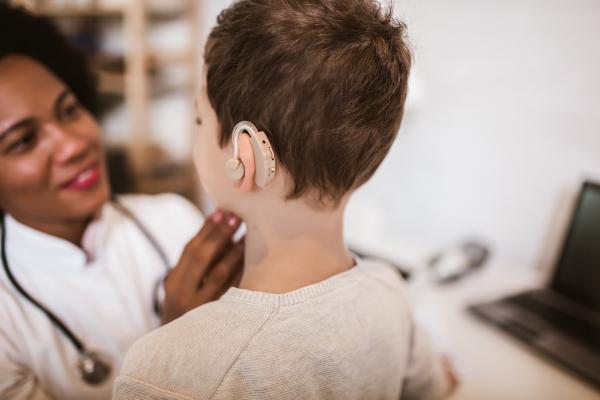
Shaw and colleagues work to support early identification and intervention for young children with hearing loss and their families
Evelyn Shaw, MEd, knows the importance of early identification of hearing loss in young children and is committed to improving outcomes for these children and their families. Shaw is an educational consultant at the UNC Frank Porter Graham Child Development Institute (FPG), where she works at the Early Childhood Technical Assistance (ECTA) Center. Last month, she and Sharon Walsh, an external consultant for ECTA and the Center for IDEA Early Childhood Data Systems (DaSy Center), presented two sessions at the Early Hearing Detection and Intervention (EHDI) national conference.
The conference presentations were a result of the ECTA Center’s work with the Centers for Disease Control and Prevention (CDC) and the EHDI Outcomes Committee since 2016. This collaboration seeks to strengthen the partnership between state EHDI programs and the state early intervention programs under the Individuals with Disabilities Education Act (IDEA) legislation. Both programs support improving outcomes for children who are deaf or hard of hearing and their families. Through the work with the EHDI Outcomes Committee—which is comprised of representatives from CDC, the federal Health Resources and Services Administration, the Office of Special Education Programs, the National Center for Hearing Assessment and Management, the parent driven non-profit organization Hands & Voices, and state EHDI and early intervention coordinators and staff—the ECTA and DaSy Centers have offered national webinars and produced web-based and print resources designed to facilitate and encourage collaborative activities between state EHDI and early intervention programs.
Providing support to states to share data is a key focus of this work. To collaborate more effectively with state early intervention programs, it is important to understand the data that is required to be reported by both programs. Both EHDI and early intervention require state programs to annually collect data. Data sharing promotes earlier identification of young children with hearing loss and provides an opportunity to evaluate the effectiveness of both programs.
“This is work that can’t be done by one group so it’s great to see state and federal agencies collaborating,” says Shaw. “It’s not always easy but it is important to give people the tools to work together.”
The Early Hearing Detection Intervention program collects data on infants who are screened for hearing loss before they are discharged from birthing or neonatal facilities, or within one month of birth. Infants who are referred from the screening process should receive a complete diagnostic audiological evaluation by three months of age. Those who are diagnosed with hearing loss are referred for early intervention by six months of age.
Other data collected that are critical to evaluating the effectiveness of the EHDI program include the number of infants that do not pass the screening, number of infants diagnosed, number of infants referred to early intervention, number who are eligible for early intervention services and the types of services on the Individual Family Service Plan (IFSP), loss to follow-up, type and severity of diagnosis, and demographic data. State early intervention programs are annually required to collect and report data on the number of infants and toddlers with an IFSP by age, sex, race and ethnicity, the early childhood outcomes of children who have been in the program for at least six months and have exited during the year, and number of children who exit and the reason for exiting.
Shaw and Walsh, along with colleagues who comprise the ECTA Child Find topic team, work to inform and improve state systems, with the goal of ensuring that all children in need of early intervention services and their families are identified, located and evaluated for eligibility for early intervention services. Assisting all partners to better understand the common data elements as well as what can be collected and shared supports state programs to identify successes and address challenges in data sharing and program improvement. Some of the EHDI Outcomes Committee’s achievements include:
- Identifying challenges and strategies to support data sharing, including examples of successful state data sharing efforts between state early intervention and EHDI programs.
- Facilitating solutions, within the privacy regulations, for data sharing between state early intervention and EHDI programs.
- Promoting and facilitating continued collaboration between federal and state partners through detailed strategies that support data sharing.
- Developing guidance from state EHDI and early intervention programs to local agencies regarding the importance of data sharing, why it is needed and strategies for sharing data.
- Developing a data sharing agreement checklist and data sharing agreement template.
Using anecdotes of successful state program collaborations and how states resolved obstacles and barriers, Shaw, Walsh, and the EHDI Outcomes Committee hope to inspire other state programs and provide resources to promote collaboration. Shaw says that working to promote collaboration between the two programs not only strengthens the ability of the programs to work together but facilitates children and families receiving needed services and resources. While it is always a family’s individual decision to participate in an early intervention program, both EHDI and state early intervention programs are committed to addressing access, disparities, and equity issues to give all children the best possible start.
Shaw says that she, Walsh, and key members of the EHDI Outcomes Committee were pleased to be invited to the conference to present to the EHDI state coordinators and their teams and to attend the Centers for Disease Control and Health Resources and Services Administration meetings. She emphasizes the importance of these groups working together. “This is work that can’t be done by one group so it’s great to see state and federal agencies collaborating,” says Shaw. “It’s not always easy but it is important to give people the tools to work together.”
